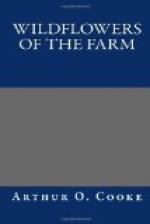Now that we have come down the steps into the foldyard we see that it lies a good deal below the house and garden. Built round the foldyard are the stables for the cart-horses, the cowhouses, and the great barn. Behind the stables is the rickyard. That, like the garden, is above the foldyard; from it there are only two or three steps to the door of the loft or “tallet” above the stables. It is there that we will go now.
The wall of the tallet is of stone and is very old; the roof is tiled. There is a little hole cut in the bottom of the door, and you will see one like it in the door of the granary. It is made so that old Tib and the other cats can go in and catch mice. Growing between the stones of the wall just by the tallet door is the plant I want to show you now.
It is the Stonecrop. Some of the stems grow upright, while others are trailing. At the top of each upright stem is a cluster of bright yellow flowers. Some of these are fully open, and we see that each blossom has five pointed petals. The trailing stems have no flowers at all, they are barren; but the leaves on the barren stems are much more numerous and closer together than those on the upright flowering stems.
[Illustration: Common stonecrop.]
These leaves are very curious. They are not flat like the leaves of the Red Valerian, the Toadflax, and most other flowers; they are very thick and fleshy—something like a short round pointed stick. They grow close against the stalk, not in pairs, but alternately, first a leaf on one side of the stalk, then a leaf on the other. They are erect too; that is, they point in the same direction as the stalk.
On the barren stems the leaves grow so closely that they quite cover the stalk. They have a hot sharp taste, and the plant is sometimes called “Wall-Pepper.” The roots are very thin and can spread easily through narrow chinks of the wall.
We will see one more plant of the walls before we look for flowers elsewhere. Our next plant is not very common at Willow Farm; still I know where to look for it. Built against one side of the big barn in the foldyard is a little lean-to shed. Often there are calves in it; but just now we are more interested in something that is on the roof.
Standing close to the wall of the shed is a cattle crib—a kind of big square box or trough on legs, in which hay or chaff is put for the cattle. The shed is not very high, and by standing on the crib we can scramble on to the roof. Here is the plant we want to see.
It is the Houseleek, of which a clump is growing between the tiles. Almost flat on the tiles is a dense mass of large green fleshy leaves. These leaves are evergreen, they do not die and fall off in winter. From this cluster of leaves rise straight thick stems nearly a foot high. The stems are thickly covered with erect leaves which grow smaller towards the top of the stem.




